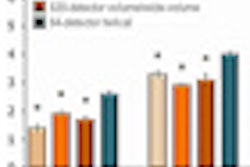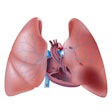The vast majority of CT exams of the abdomen and pelvis in U.S. emergency departments are ordered for clinically complex cases, suggesting that fears of CT overuse in simple clinical cases are largely unsupported, according to a study in the June Journal of the American College of Radiology.
The analysis of Medicare data for 2007 examined emergency department (ED) evaluation and management codes occurring at the time of care to determine clinical severity. The researchers found that more than 90% of all ED encounters with CT scans of the abdomen and/or pelvis (CTAP) were performed in complex cases. Among other things, the results show that growth in CT utilization in emergency departments in recent years is probably not caused by ordering scans for less serious cases, according to the authors.
"The overwhelmingly greater likelihood of the use of CTAP in higher complexity settings argues against widespread indiscriminate overuse of CT in lower complexity ED settings as a significant driver of increasing utilization," wrote Dr. Richard Duszak, from the University of Tennessee Health Science Center, along with colleagues from other U.S. centers and the American College of Radiology (JACR, June 2012, Vol. 9:6, pp. 409-413).
"In the ED and other acute settings, advanced imaging in general and CTAP in particular have been demonstrated to shorten ED wait times, facilitate triage of both trauma and nontrauma patients, decrease the frequency of unnecessary exploratory surgery, and shorten overall hospital lengths of stay," the group wrote. "Not surprisingly, then, the utilization of CTAP has increased considerably in recent years, in both the ED and a variety of other settings."
The increase in imaging volume has led some to question the decision-making process for ordering CT -- specifically, whether the scans were justified. The study was undertaken to assess the association of patient complexity with regard to CT's utility in the emergency department for abdominal and pelvic scans.
The researchers identified all 2007 Medicare beneficiaries for ED visits and analyzed a random 5% of claims. As a surrogate for evaluating the complexity of cases, the five CPT codes for ED patient evaluation and management (E&M) were used for the initial patient visit, and patients who underwent CTAP on the same day were used in the analysis.
From a total of 1,081,000 patient encounters, 306,401 (28.3%) were of lower complexity and 774,599 (71.7%) were of higher complexity. Among the encounters in which CTAP was performed, however, the numbers favored scans in the more complex cases. Among the 65,273 encounters in which CTAP was performed, 61,204 (93.8%) were higher complexity cases.
CT abdominal/pelvic exams by complexity
|
Although lower-complexity ED encounters overall were less frequent than higher-complexity encounters (28.3% versus 71.7%), the difference in use of CTAP in lower- versus higher-complexity encounters was highly statistically significant (p < 0.001).
When the lower-complexity patients were scanned, abdominal or pelvic CT alone was performed in 11.6% of cases, compared with 7.7% for the higher-complexity cases. The scans were performed together in 88.4% of the low-complexity cases and 92.3% of the high-complexity cases, a statistic that reached statistical significance (p < 0.001).
Finally, there were considerable differences in both the time and intensity of physician E&M services between the lower- and higher-complexity groups. Typical physician work times were from 13 minutes to 30 minutes less for the lower-complexity code group. In addition, the intensity of work time for each CPT code in the lower-complexity cases was less than those for the higher-complexity code group.
"Although 28.3% of ED patient encounters were categorized as low complexity on the basis of our E&M coding criteria, only 6.2% of the ED CTAP was performed in this patient group," the authors wrote.
"The overwhelmingly greater likelihood of the use of CTAP in higher-complexity settings argues against widespread indiscriminate overuse of CT in lower-complexity ED settings as a significant driver of CT utilization," they wrote. "Despite pressures on ED physicians from the threat of medical liability and the challenges of the Emergency Medical Treatment and Active Labor Act ... our results suggest that CTAP is not routinely used in the evaluation of their lesser complex patients."



















